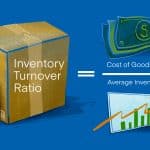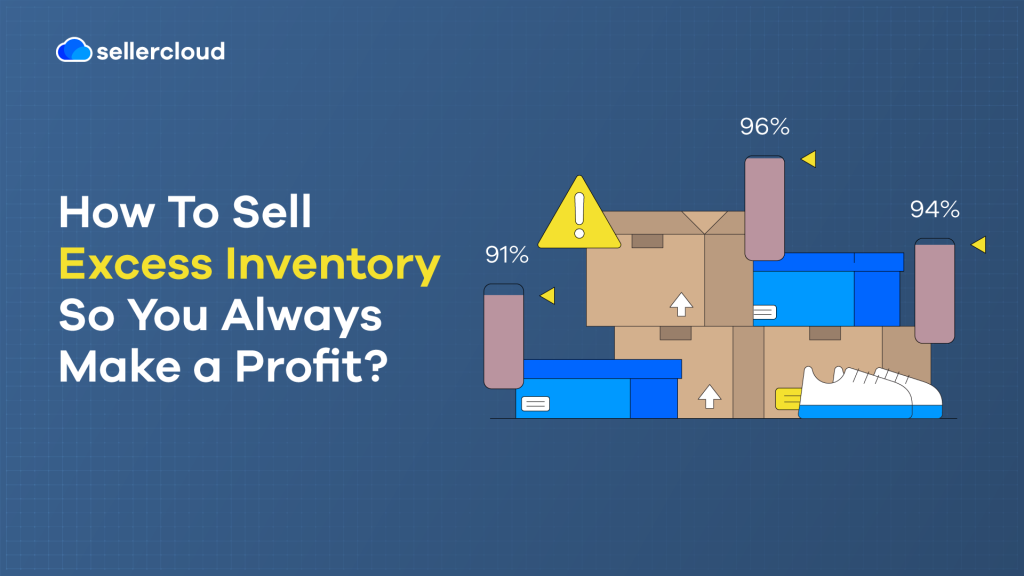
- Excess inventory is a problem; merchants can end up with too much stock in many ways. However, there are several ways to make a profit from excess inventory.
- Descartes Sellercloud enables merchants to better handle and distribute their inventory across multiple channels.
Having a ton of extra inventory lounging around in your warehouse and not moving is not particularly pleasant. What makes it even worse is knowing that it’s cutting into your business’s profitability. In an ideal world, products should leave your inventory just as fast as they enter and avoid taking up valuable space, but that’s not always possible in the real world.
Interestingly, excess inventory may be a bigger problem than most merchants realize. According to an article by Retail Customer Experience.com, “The average U.S. small store is sitting on $48,000 of excess stock – equivalent to 22% of their overall inventory.” They also added that more than half of these businesses said they’d have no choice but to liquidate if they failed to sell excess stock.
We explain several ways merchants can profit from their excess inventory, limit the causes of excess inventory in the future, and how Descartes Sellercloud can help.
Why Get Rid of Excess Inventory?
Excess inventory can cause a variety of problems for your business. It can tie up capital, take up precious storage space, and increase the risk of obsolescence, to name a few. By eliminating excess inventory, companies can free up capital to invest in more profitable business areas and reduce carrying costs.
Additionally, it allows businesses to optimize their inventory levels, ensuring they have the right amount of stock to meet customer demand without accidentally overstocking. It also keeps your business flexible, enabling it to invest in new stock and take advantage of short-term trends.
Most importantly, though, selling excess inventory helps maintain a healthy cash flow, which is vital for businesses to survive, and mitigates the potential loss of value of your stock over time. Reducing excess inventory is a proactive approach that keeps your business agile, efficient, and profitable.
It should be noted that excess inventory is not the same as safety or buffer stock, which is the additional stock that you reserve just in case there is higher-than-expected demand. However, there is a risk that safety stock could become excess inventory.
How Does Excess Inventory Affect Your Profitability?
Excess inventory can significantly drain a business’s profitability. A smoothly running company aims to balance its inventory so it comes in and goes out efficiently. Excess inventory cuts into your storage space, which could be used for products that leave shelves faster. Essentially, you’re losing money by not using that storage space for products that sell faster.
To make things worse, excess inventory also depreciates the longer it is not sold, so when you finally manage to sell it all, the profits could be smaller, or you could even make a loss. On top of that, if you’re using a fulfillment service, like Amazon’s FBA (Fulfilled By Amazon), Amazon may impose fees on your inventory if it is not moving.
In the worst-case scenario, excess inventory can become obsolete and practically worthless. This can happen when technology changes or something becomes no longer fashionable. Sometimes, excess inventory simply can’t be profited from; it is too burdensome, and it would be much wiser to offload it—even if you sell it eventually, you can still make a loss.
What Should a Business Owner Do With Excess Inventory?
Business owners seek to offload their excess inventory as quickly and efficiently as possible. Ideally, business owners want to profit from any excess inventory. However, if that’s not possible, businesses will at least want to make excess inventory less of a drain on resources.
This could mean liquidating it or paying to have it destroyed (and there’s no way to profit from that).
In some cases, businesses may want to donate excess inventory to charity. This will not be profitable either, but it will show your company favorably, which could encourage more customers to buy from you. If you decide to donate excess inventory to charity, make sure you tell potential customers about it. It won’t benefit your business if customers don’t hear about it.
How to Make Money With Excess Inventory? 8 Ways
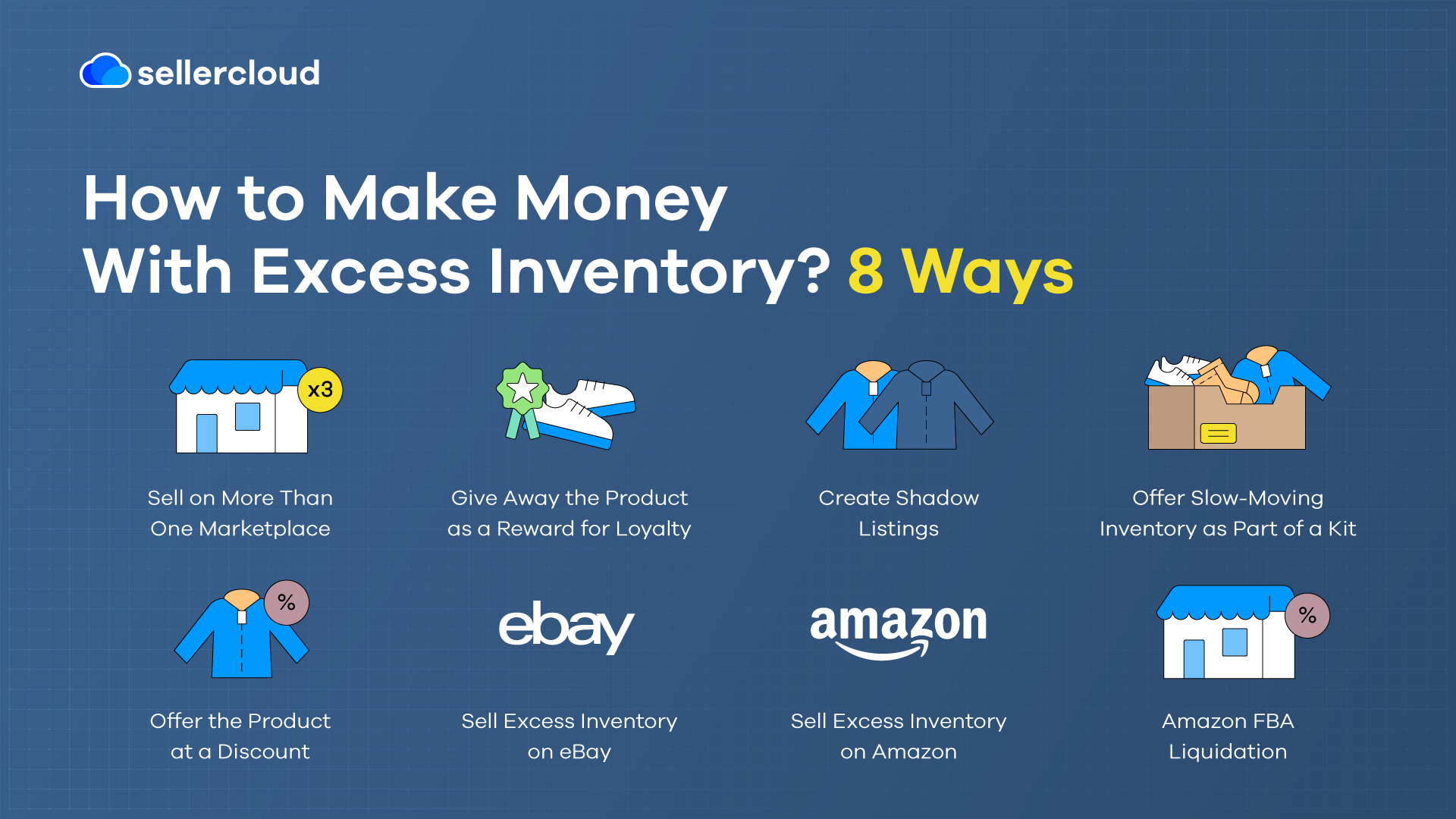
There are many ways to turn your excess inventory into profitable inventory, but remember that not every strategy will work for you. It depends on your company’s situation.
1. Sell on More Than One Marketplace
Your business’s excess inventory problem might be that you are missing the real audience for your products by selling on only one marketplace.
Different marketplaces attract different types of buyers, and the ideal buyer for your products may purchase products on a different marketplace. For example, you may sell primarily on Amazon, but your products may suit eBay better. You may discover that you don’t have an excess inventory problem when selling on multiple marketplaces.
Some marketplaces have lower fees, which may improve your business’s profitability, and others, such as Overstock and Back Market (both integrated with Descartes Sellercloud), specialize in excess inventory.
2. Give Away the Product as a Reward for Loyalty
Excess inventory can easily be utilized as a reward for return customers to encourage loyalty and to continue buying from your business.
Return customers can be highly undervalued. It can be more profitable to encourage return customers than to acquire new ones. According to some estimates, acquiring new customers can cost five times more than focusing on retaining your existing customers, who typically will spend more at your store than new customers.
Rewards can also be offered for referrals—get customers to refer a friend and give them a free gift if the referred customer makes a purchase.
3. Create Shadow Listings
A shadow listing is where merchants create an alternative listing profile for a product. It is a great way to experiment with capturing customers’ attention in new ways. Shadow listings could have different titles, descriptions, and even images.
Multiple listings can boost the visibility and sales of slow-moving inventory, and shadow listings could sell better than the original listing. Creating shadow listings is a unique feature offered by Descartes Sellercloud.
4. Offer Slow-Moving Inventory as Part of a Kit
Kitting is a highly effective way to reduce excess or slow-moving inventory. You may also know it as ‘bundling.’ In short, kitting is where sellers sell several products as a package under one SKU. Kitting can help reduce excess inventory by pairing products that sell well with those that don’t.
Furthermore, kitting reduces packing and shipping costs and increases the value of shipments, making your business more profitable. With Descartes Sellercloud, you can also generate shadow listings of kits, which can further increase the exposure of your slow-moving inventory.
5. Offer the Product at a Discount
Of course, there is the risk that offering the product at a discount will not be profitable, but cutting prices can at least reduce your loss and free up space in your inventory for new products. Discounts can also be given for bulk quantities, though this can depend on the product type.
If you urgently need to offload excess inventory, you may want to consider a steep discount, which will cut further into your potential profits.
6. How to Sell Excess Inventory on eBay?
As mentioned above, eBay is arguably one of the best places to sell excess inventory and reach new customers, but even on eBay, it’s not always so straightforward. If you’re struggling to sell excess inventory on eBay, you can try several things. A great option is to use eBay’s promotional features, such as ‘Promoted Listings’ or ‘Markdown Manager.’
Promoted Listings increase the visibility of your excess inventory in search results, while the Markdown Manager allows you to offer discounts and highlight the reduced prices.
You can join eBay’s markdown sales events, such as seasonal promotions or themed campaigns. During these events, buyer traffic is often increased, which can increase your store’s visibility and potentially help alleviate excess inventory.
Before you do any of this, ensure that your listings are optimized for your target buyer. You can also utilize email marketing to draw in more buyers. Furthermore, eBay is one of the many marketplaces where merchants can create shadow listings (explained above) with Descartes Sellercloud to boost the sale of excess inventory.
7. How to Sell Excess Inventory on Amazon?
You can try a few things if you’re already selling on Amazon and struggling to sell excess inventory. Firstly, though, ensure your selling account is in good standing. Poor performance metrics could limit your exposure to customers on Amazon’s marketplace.
In addition, like eBay, ensure your listings are optimized and experiment with email marketing to attract more buyers. You should also make sure your listings are complete. Sometimes, a small mistake, such as listing the product in the wrong category, can cause your inventory to build up.
One thing you can try is Amazon’s Warehouse Deals program. Amazon Warehouse is a secondary marketplace where you can sell excess inventory as ‘open box,’ and it appeals to bargain hunters. Amazon also holds various seasonal promotions, such as Prime Day and holiday sales. If one is coming up, you can optimize the listings of your excess inventory in preparation.
Finally, just like with eBay, Merchants can also use Descartes Sellercloud to create shadow listings on Amazon to increase the sale of excess inventory.
8. What Is Amazon FBA Liquidation?
If the above suggestions are still not cutting it and you’re utilizing Amazon’s FBA service, Amazon FBA Liquidation might be the only option to offload any excess inventory. Liquation is a method of selling a company’s entire stock, and it’s typically reserved for companies that are going out of business.
In FBA liquidation, Amazon handles selling the inventory on behalf of the merchant, as well as customer service and shipping logistics, which makes it highly convenient. However, as expected, products are typically sold at discounted prices to buyers looking for deals.
Who Buys Excess Inventory?
Believe it or not, there is a large market for excess inventory, and many companies could be interested in buying it. As the saying goes, one man’s trash is another man’s treasure.
Wholesale Buyers
Wholesale buyers purchase surplus stock in bulk at discounted prices. They then resell the products to retailers or other businesses, making it a win-win situation for both parties.
Liquidation Companies
Liquidators specialize in buying excess inventory from businesses and reselling it through their own channels. They often buy large quantities and can offer competitive pricing, helping you quickly offload surplus stock.
Discount Retailers
Discount stores thrive on offering discounted products to their customers. Excess inventory with discounted prices can be a great fit for these retailers who are always looking for deals to pass on to their value-conscious shoppers.
Exporters
Exporters have the knowledge and connections to distribute products in specific regions or countries that might be beyond your reach. If your excess inventory has international appeal, exporters may be interested in purchasing it for overseas markets.
Secondary Market Buyers
These buyers include individuals or businesses seeking unique or niche products. They may purchase excess inventory for personal use or creative projects or resell them through other online marketplaces.
What Causes Excess Inventory?
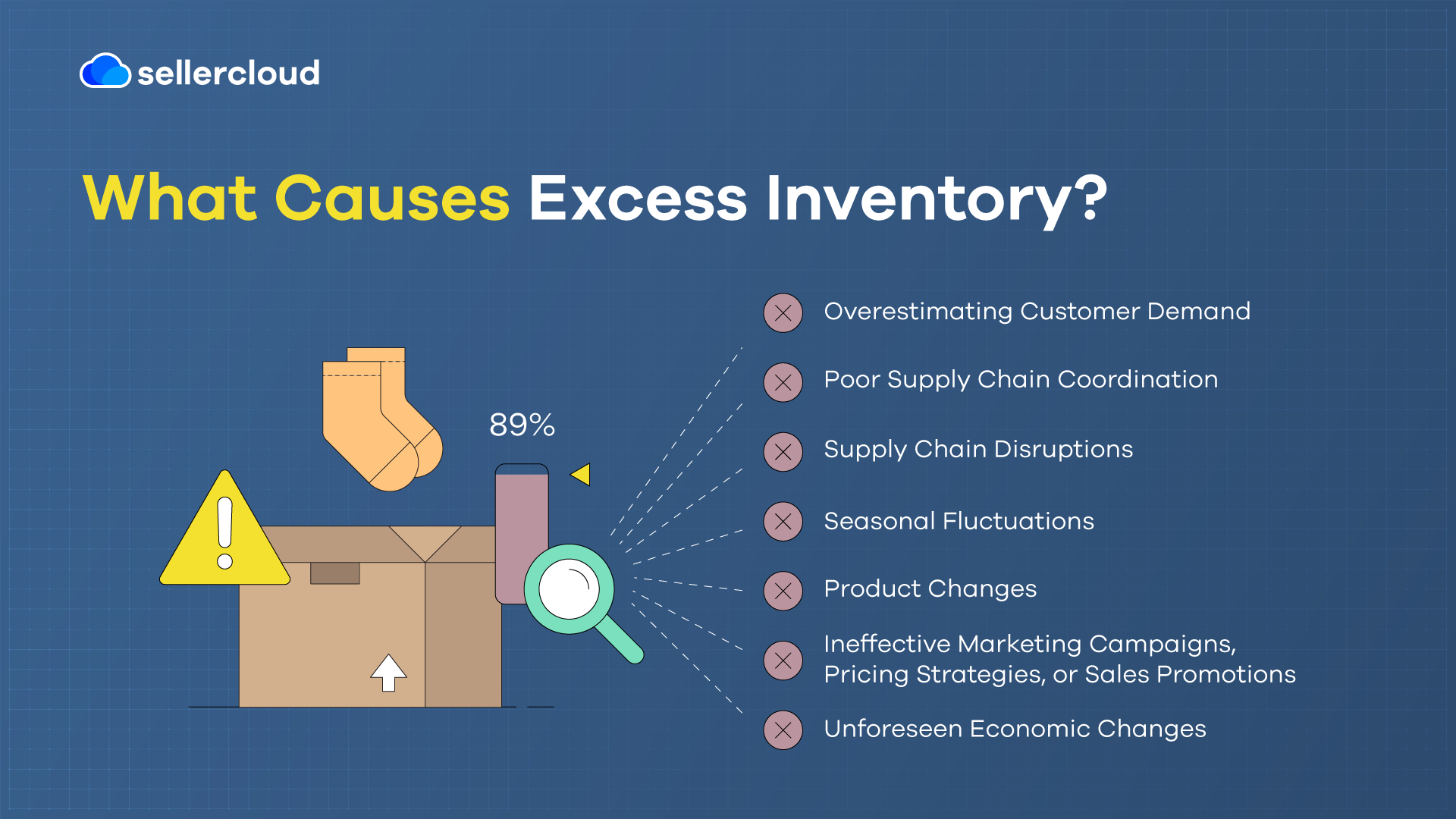
Stopping excess inventory from happening in the first place is the best way to keep it profitable. So, let’s look at some common ways businesses end up with too much inventory.
One of the main causes of excess inventory is when businesses overestimate customer demand for a product. Poor supply chain coordination can also lead to excess inventory. This could be caused by production delays or slow shipping, for example, and inventory can pile up.
Furthermore, supply chain disruptions, such as delayed deliveries or sudden changes in supplier agreements, can unintentionally impact a merchant’s inventory levels. Businesses that experience seasonal fluctuations can also end up with excess inventory during off-peak seasons or if something impacts regular selling during peak seasons.
Product changes can also be a significant cause of excess inventory. New versions of products can render older inventory obsolete if businesses fail to sell the existing stock before transitioning. Customers will demand the new product version, leaving older versions to accumulate and become obsolete.
Lastly, ineffective marketing campaigns, pricing strategies, or sales promotions can lead to slower-than-expected sales, resulting in excess inventory.
However, sometimes unforeseen situations emerge, and no matter how prepared you are, you still have to deal with the challenge of excess inventory—for example, unforeseen economic changes. The pandemic and the surge in inflation that followed are two recent examples we can point to. It’s not always a business’s fault when it has excess inventory.
How Is Excess Inventory Calculated?
By properly calculating what constitutes excess inventory for your business, you can potentially avoid excess inventory building up in your warehouse.
To calculate excess inventory, you must figure out your average sales rate and your current inventory levels. Your average sales rate can be determined by analyzing historical sales data over a specific period, such as a month or a quarter.
Using this data, you can identify the average number of units sold daily and estimate your expected sales within a timeframe. Meanwhile, assessing current inventory levels involves counting the stock you have or, if you have an inventory management solution like Descartes Sellercloud, checking real-time updates (so you don’t have to count physically).
Once you have this information, you can compare your current inventory levels with your average sales rate. If your current stock exceeds the expected demand based on your sales rate, you may have excess inventory.
Calculate the excess by subtracting the expected sales from the actual inventory on hand. The resulting figure represents the excess inventory that needs to be addressed.
How Do You Reduce SLOB Inventory?
‘SLOB’ inventory is short for ‘slow-moving and obsolete’ inventory. Excess SLOB inventory is very easy to accumulate as it literally has nowhere else to go. The first step to reducing SLOB inventory is to identify slow-moving and obsolete items in your inventory. Note that what you categorize as SLOB inventory might differ from other businesses.
You can use sales data, product demand, and current market trends to determine which of your inventory is SLOB inventory. Some of the best methods for reducing SLOB inventory are ones we’ve already mentioned in this article—sales events, discounts, kitting, loyalty rewards, liquidation, and using multiple marketplaces.
Can You Write Off Excess Inventory?
Writing off excess inventory is the accounting practice of recognizing it as a loss on financial statements. It is possible to write off excess inventory when it is obsolete, damaged, or unsellable.
Writing off inventory can vary depending on accounting regulations and the company’s policies. Writing off excess inventory allows businesses to reflect the value of their assets accurately and maintain accurate financial records.
How to Handle Your Inventory Better With Descartes Sellercloud?
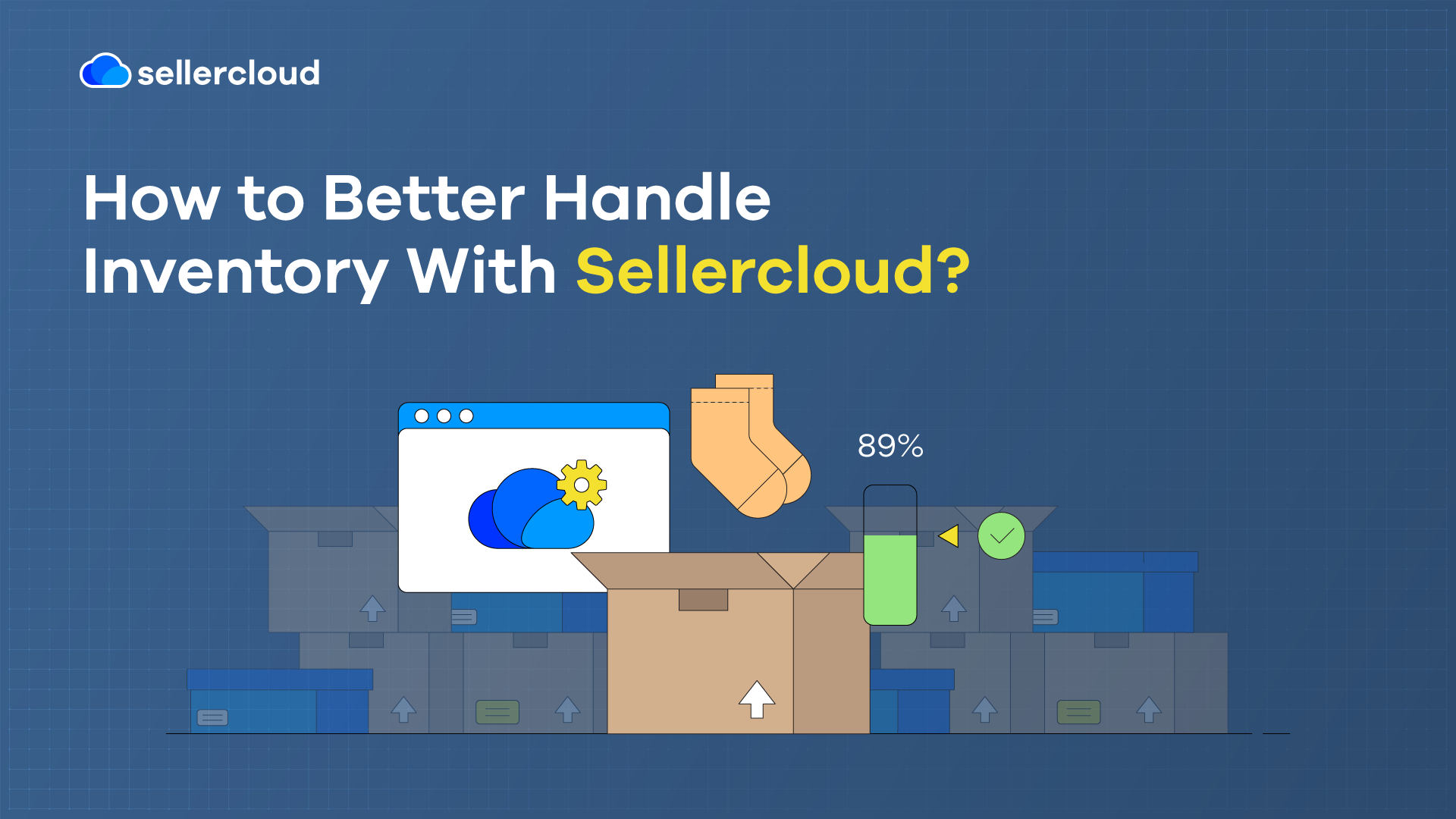
Calculate, monitor, distribute, and manage your inventory better with Descartes Sellercloud and prevent inventory calamities before they start.
With Descartes Sellercloud, you can sell on multiple channels and monitor everything from one place—there’s no need to log in and out of several marketplaces. This enables sellers to spread their inventory across multiple marketplaces, making it less likely to become burdensome.
But that’s not all. Descartes Sellercloud has many integrations to help sellers manage inventory and run profitable ecommerce businesses.
Book a Descartes Sellercloud demo today.
Key Points
Say goodbye to excess inventory! Remember these key points.
- Excess inventory takes up space that could be used for more profitable products, makes your business less flexible to changing demand, and is at risk of depreciating or becoming obsolete.
- Profiting from excess inventory is possible—sellers do this in various ways, depending on their options.
- However, sometimes, profiting from excess inventory is impossible, and the best you can do is cut or reduce your losses.
- Excess inventory can be reduced from building up in your warehouse, though sometimes the situation is beyond your control.
- Monitoring and distributing inventory across multiple marketplaces is easy with Descartes Sellercloud.


